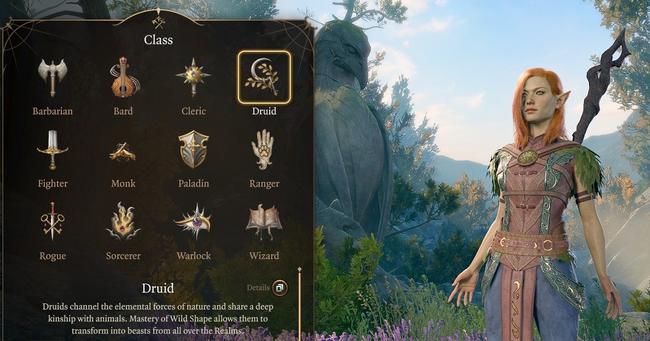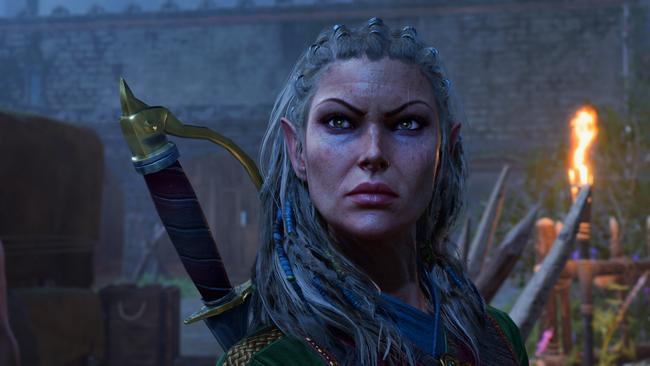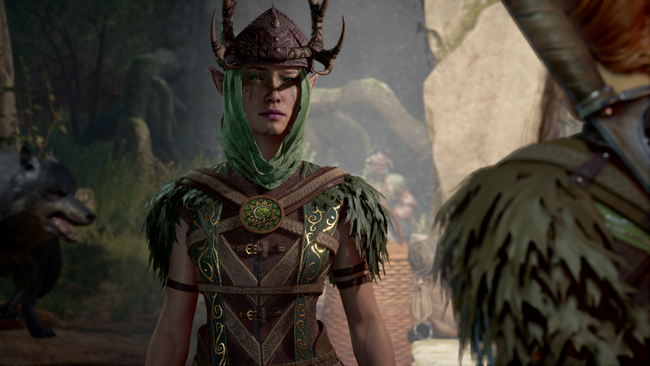
Baldur's Gate 3 Druid Class Guide - Subclasses, multiclassing, and how to turn into a Bear
The avatar of nature itself in mortal form, the Druid is the crunchiest spellcaster in Baldur’s Gate 3. At first glance, there doesn’t seem to be a ton of daylight between Druids and Clerics, another class known best as a supportive spellcaster. That changes when the Druid morphs into a bear or other powerful beast and mauls the heck out of some baddies. Druids are powerful and self-sufficient, mastering the elements and blessings of nature to help their allies and harm their foes.

Before You Begin
Note that none of these points are set in stone. Build your character the way you choose, and see these notes more as suggestions than rules.
This guide will also assume that you are building a custom character. Origin Characters have unique interactions and roleplaying options available thanks to their preset nature. At the moment, there are no Druid Origin Characters in Baldur’s Gate 3 other than the Dark Urge, who is customizable in terms of race and class. If you’d like to play a Druid Origin Character, consider choosing The Dark Urge as your Baldur’s Gate 3 protagonist.
There are, however, recruitable Druid companions. You can meet and eventually recruit Halsin, a Wood Elf Druid.
Additionally, this guide presumes you are building a single-class character. Multiclassing into different classes as you level up is an option to gain new and useful abilities, but there’s also value in specialization. We’ll have some multiclass suggestions for you at the end of the guide.
The Druid Playstyle
Just as life and nature find a way to overcome any obstacle, the Druid is a spellcasting class that emphasizes a level of versatility not fully shared by other “supportive” spellcasters like the Cleric or the Bard. Druids can use their spells to heal and support the party, but they can just as easily turn their nature-tuned powers to become a capable close combatant or even a damage-dealing, well, force of nature. They also have unequaled levels of control over areas of the battlefield, turning whole combat zones into no-man's-land for the party's enemies.
Druid subclasses are also quite varied, changing up a Druid’s playstyle dramatically depending on the player’s choice.
Due to some gear restrictions, Druids can be a bit more vulnerable physically than Clerics, which will require some more judicious tactics to ensure that your Druid isn’t too exposed to enemy aggression, at least not until it’s time to maul them to death as a fearsome animal.

Druid Class Features
- Key Abilities: Wisdom and Intelligence
- Like Clerics, Druids use Wisdom as their main spellcasting ability score. However, they also use Intelligence as their second ability bonus on saves, giving them proficiency bonuses when using knowledge-based skills.
- Gear Proficiency: Light Armor, Medium Armor, Shields, Clubs, Daggers, Darts, Javelins, Mace, Quarterstaves, Scimitars, ickles, Spears, Slings
- Skill Proficiency: At creation, Druids can choose two proficiencies from Arcana, Animal Handling, Insight, Medicine, Nature, Perception, Religion, and Survival. Wisdom-based skills like Animal Handling and Medicine will benefit from the Druid’s natural Wisdom bonuses, as will Intelligence-based skills like Arcana or Nature.
- Druid Spellcasting: Druids channel the power of nature through their magical spells. They can add new spells as they gain levels, and need to prepare them before being able to cast them (with some exceptions).
- Wild Shape: This is what separates the Druids from the “civilized” casting classes. Druids can take on the shape of a powerful beast with unique ability scores and powers. When taking on a Wild Shape, Druids can’t cast spells or talk (they revert to normal form when conversing), but retain their Wisdom, Intelligence, and Charisma scores. Their gear also merges into their animal form and doesn’t affect them until they revert. At release, Baldur’s Gate 3 offers eight Wild Shape options, with more unlocked based on their subclass choice.
- Badger - A form that can burrow into the ground and emerge elsewhere.
- Bear - An ursine wild shape with a lot of HP and a taunt ability.
- Cat - A stealthy form that can distract foes.
- Dire Raven - A flight-capable form with a blinding ability.
- Deep Rothe - A bovine form that has a charge move and an illuminating spell.
- Owlbear - A powerful combat form that can use multiple attacks.
- Spider - An agile form that can ensnare enemies in webs.
- Wolf - A pack-supporting form that can score a guaranteed critical and increase its allies’ movement speed.
Druid Gear Recommendations
- Druids have a somewhat specific list of equipment they can use. There's also a lore-related "prohibition" in that according to Dungeons & Dragons class descriptions, most druids dislike wearing metal armor. This restriction isn't enforced in Baldur's Gate 3, but if you're intent on roleplaying, a Druid's preference for natural materials can make them a tad more vulnerable than their peers.
- That said, the right choice of Wild Shape can make up for that physical gap, since a Wild Shape uses the physical stats of their animal form, ignoring their armor and weapons. Your Druid might be a bit squishy as a human or an elf or whatever, but will almost certainly be less vulnerable in the form of a bear or something tougher.
- Druids also have access to one of the most useful melee-related powers available to a Wisdom-based caster: the Shillelagh cantrip. This move allows them to do magical damage with their weapon and use their Wisdom modifier for attack rolls (instead of Strength). Thus, a Druid can output surprising damage (for a caster) in close combat, even without the aid of their Wild Shape.

Druid Subclasses
Level 2 Druids select a “Circle” as their subclass. Each of the Circles available in Baldur’s Gate 3 emphasizes a particular style of play for the Druid, such as spellcasting, the Wild Shape, or a more exotic approach that emulates the more morbid side of the life cycle.
Circle of the Land
Druids in the Circle of the Land focus heavily on the spellcasting aspect of the class. They effectively attune themselves to a certain biome, such as Arctic or Coast, and gain new spells, some of them from other classes’ spell lists, that are treated as always prepared. In a way, a Land Druid’s choice of biome is similar to a Cleric’s Divine Domain choice.
For the sake of readability, we won’t list every circle spell you can gain, but focus on notable additions. Some Circle Spells overlap between different biomes.
Circle of the Land Subclass Features
- Bonus Cantrip: An additional druid cantrip of your choice.
- Natural Recovery: A short rest will recover some expended spell slots.
- Notable Circle Spells: Choose a biome to connect to, which determines your associated spells, gained at levels 3, 5, 7, and 9.
- Arctic: Spike Growth, Ice Storm, Cone of Cold
- Coast: Mirror Image, Conjure Elemental, Misty Step
- Desert: Blur, Protection from Energy, Insect Plague
- Forest: Barkskin, Call Lightning Spider Climb
- Grassland: Invisibility, Haste, Daylight
- Swamp: Melf’s Acid Arrow, Stinking Cloud, Scrying
- Underdark: Web, Gaseous Form, Cloudkill
- Nature’s Ward: Immunity to poison, disease, and charm or fright effects from fey and elementals
- Land’s Stride: Free movement through difficult terrain, resistance to magical plant growth and plant-related hostile effects.
Circle of the Moon
Moon Druids are all about transformation, using an upgraded version of their Wild Shape to fully draw out the power of the animal kingdom. While even a Moon Druid won’t quite have enough uses of Wild Shape to remain that way for every single encounter, their subclass emphasis on Wild Shape means that they’ll be less available for spellcasting. However, their Wild Shapes are truly powerful, and can even take the place of dedicated close-combat classes in some party compositions.
Circle of the Moon Subclass Features
- Combat Wild Shape: Can Wild Shape as a bonus action, and can use Lunar Mend to heal in combat.
- Circle Forms: Additional powerful Wild Shape forms, including Owlbear, Deep Rothe, Dire Raven, and more.
- Elemental Wild Shape: Can transform into an Elemental(Earth, Air, Fire, Water).
- Primal Strike: Beast form attacks are considered magical when calculating resistance.
Circle of Spores
In the eyes of some, Druids from the Circle of Spores revel in the unnatural, with a focus on death and decay that verges on necromancy. Spore Druids, however, recognize that such things are a part of life itself. Their powers focus on bringing strong offensive options that don’t interfere with the Druid’s standard spellcasting tempo.
Spore Druids also belie some of the vulnerability of normal-form Druids, since their signature abilities thrive in melee range, allowing them to somewhat wade into the thick of combat without worrying too much or using their Wild Shape.
Circle of spores Subclass Features
- Circle Spells: Gain access to certain spells at Level 2, 3, 5, 7, and 9.
- Notable Circle Spells: Chill Touch, Blindness/Deafness, Animate Dead, Cloudkill
- Halo of Spores: The Druid is surrounded by a cloud of invisible necrotic spores that will deal damage to nearby enemies.
- Symbiotic Entity: Use a charge of Wild Shape to gain temporary HP, deal additional Halo of Spores damage, and add Necrotic damage to melee attacks.
- Fungal Infestation: Reanimate a corpse as a zombie with spores.
- Spreading Spores: Seed an area with spores, dealing damage to creatures in the area.

Druid Level Progression
These are the class features you’ll get as you level up as a Druid. The maximum level cap in Baldur’s Gate 3 at launch is Level 12. Use this to see what you’ll get at each level and plan accordingly, in case you wish to multiclass.
This guide will also highlight class features you gain based on your subclass choice. For more detailed info about the subclasses, see the sections above. Features gained by a Subclass are labeled with the Subclass name.
Note: Unlabeled benefits are “standard” class features and common to all subclasses.
Level 1
- Druid Spells:
- 2 Cantrips
- 2 Level 1 spell slots
Level 2
- Druid Spells:
- +1 Level 1 Spell Slot (3 total)
- Wild Shape
- Choice of Circle
- Land: Bonus Cantrip, Natural Recovery, Circle Spells
- Moon: Combat Wild Shape, Lunar Mend
- Spores: Halo of Spores, Circle Spells, Symbiotic Entity
Level 3
- Druid Spells:
- +1 Level 1 spell slot (4 total)
- 2 Level 2 spell slots
Level 4
- Druid Spells:
- +1 Level 2 Spell slot (3 total)
- +1 Cantrips known (3 total)
- Feat Selection: Can pick a Feat from All Classes Feat list. While any class at level 4 can pick any of the Feats, not all will be relevant to the class. You can also choose an ability improvement to boost a bonus or eliminate a penalty.
- For Clerics, we recommend one of the following Feats:
- Ability Improvement - 2 points to distribute to any Ability score (to max of 20).
- Mobile - Increases Move speed, Dash distance becomes unaffected by terrain. When moving after a melee attack, you do not provoke an Opportunity Attack.
- Magic Initiate: Druid - Learn 2 cantrips, 1 Level 1 spell from Druid Spell List. Use Wis modifier for spellcasting.
- Shield Master - +2 to Dex Saving throws when using a Shield. On successful Dex saves with a shield, you take no damage.
- Skilled - Gain Proficiency in 3 Skills of your choice.
- Tough - +2 HP per level
- Weapon Master - +1 to Str or Dex, gain Proficiency with 4 weapons of your choice.
- For Clerics, we recommend one of the following Feats:
Level 5
- Druid Spells:
- 2 Level 3 spell slots
- Land: Circle Spells
- Spores: Circle Spells
Level 6
- Druid Spells:
- +1 Level 3 spell slot
- Land: Land’s Stride
- Moon: Primal Strike
- Spores: Fungal Infestation
Level 7
- Druid Spells:
- 1 Level 4 Spell slot
- Land: Circle Spells
- Spores: Circle Spells
Level 8
- Druid Spells:
- +1 Level 4 Spell slot (2 total)
- Feat Selection: Can pick a Feat from All Classes Feat list or Ability Score Improvement.
- Improved Destroy Undead: Destroy Undead is more likely to succeed.
- Domain Feature:
- Life, Trickery, Nature, Tempest, War: Divine Strike - Extra damage on weapon attack
- Light, Knowledge: Potent Spellcasting - + Wis Modifier to damage from cantrips
Level 9
- Druid Spells:
- 1 Level 5 Spell slot
- +1 Level 4 spell slot (3 total)
- Spores: Circle Spells
- Land: Circle Spells
Level 10
- Druid Spells:
- +1 Level 5 Spell slot (2 total)
- +1 cantrip known (4 total)
- Land: Nature’s Ward
- Moon: Elemental Wild Shape
- Spores: Spreading Spores
Level 11
- Druid Spells:
- 1 Level 6 Spell slot
- Improved Destroy Undead
Level 12
- Feat Selection: Select a feat or improve an Ability Score.

Multiclass Druids
Druids tend to work best when they’re focusing on the abilities they have unique to themselves, but they can reap benefits from certain multiclass choices.
A Druid might take a level or two in Ranger to gain new weapon proficiencies and improve their durability. Some gear restrictions still apply, though. A druid can also take advantage of the Ranger’s favored enemy and terrain to further improve their combat capabilities.
A Druid with a level in Monk will gain a powerful ability that adds their Wisdom bonus to AC, improving their armor class when wearing light armor.
Druids can opt to improve their meager weapon selection with a level of Fighter. This also gives a Druid access to Fighting Styles. In a Druid's case, the "Defense" Fighting Style that improves Armor Class can help if they opt to role-play as the kind of character that eschews metal armor.